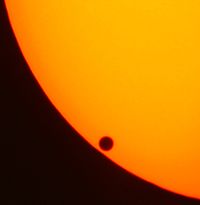The annular solar eclipse on May 20th isn’t the only light show in the solar system this year. On June 5th there will be a transit of Venus, an even rarer occurrence. If you still have your special eclipse viewing glasses, you can use them to observe the transit of Venus across the sun. Just don’t look at the sun without the right equipment. Ordinary sunglasses won’t do, and you can do serious and irreparable damage to your eyes by looking directly at the sun.
So what is a transit of Venus and why is it special? Venus’s orbit is closer to the sun than the Earth’s orbit. During a transit, Venus can be seen from Earth as a small black disk moving across the face of the Sun. The last transit was in 2004, and the next will not occur until 2117, one hundred and five years from now. If you miss it this time, you will never have another chance!
In 1769 Captain James Cook traveled from England to Tahiti to observe a transit of Venus. His voyage was part of a worldwide scientific effort to observe the transit from several locations on the Earth. The aim was to make precise observations of the slight difference in the time of either the start or the end of the transit from widely separated points on the Earth’s surface. Then the distance between the points on the Earth could be used to calculate the distance to Venus and the Sun via triangulation.
Today scientists are still interested in observing a transit. They hope to get more information about the atmosphere of Venus, as well as refine techniques for searching for planets outside our solar system.
In North America the transit will be visible at sunset on Tuesday, June 5th. Use special solar-viewing glasses, or #14 welder’s glass, or a pinhole camera to see the show. It’s a wonderful way to get a feeling for how big our solar system really is.
Posted by Nancy, who plans to join the family for a transit-viewing party.